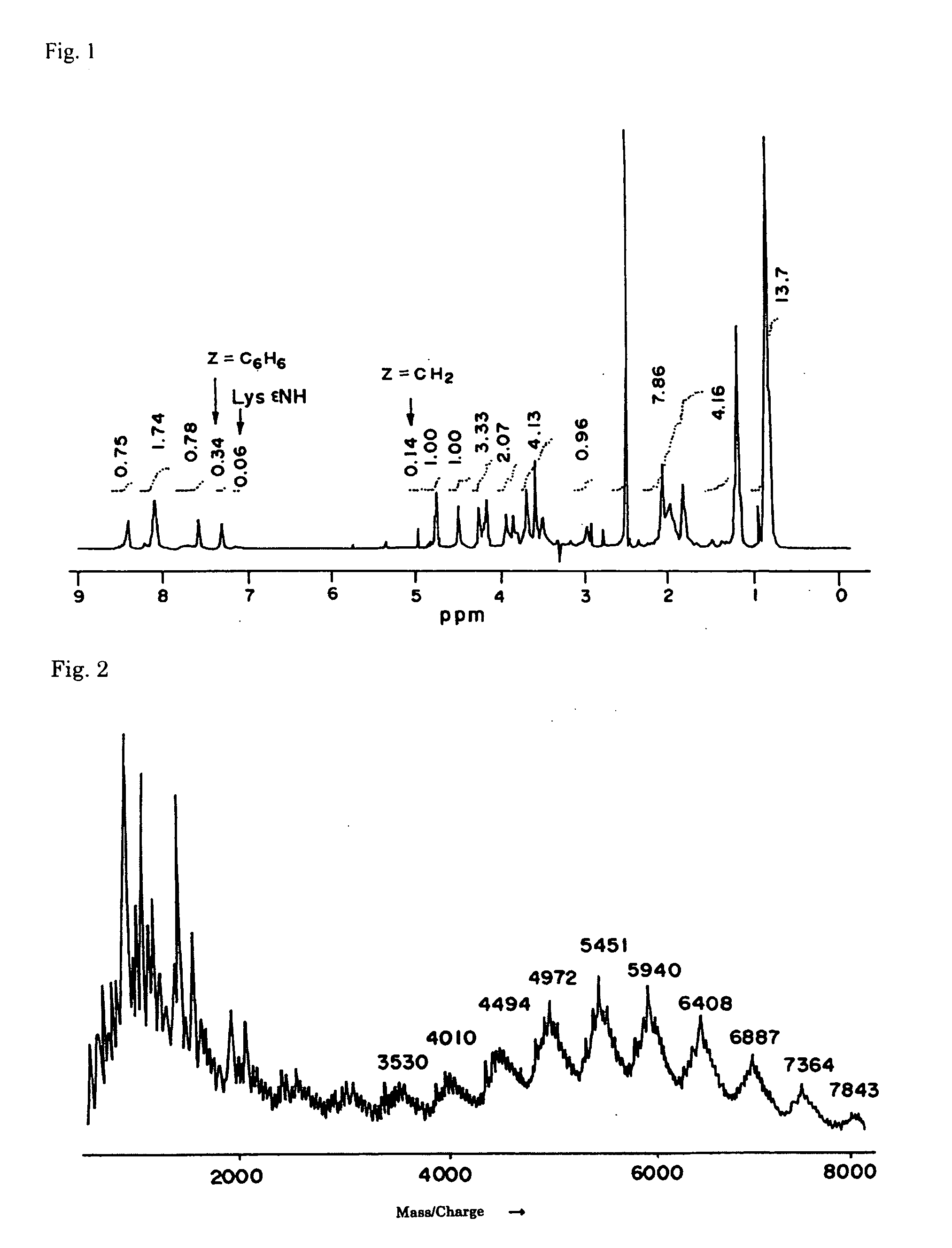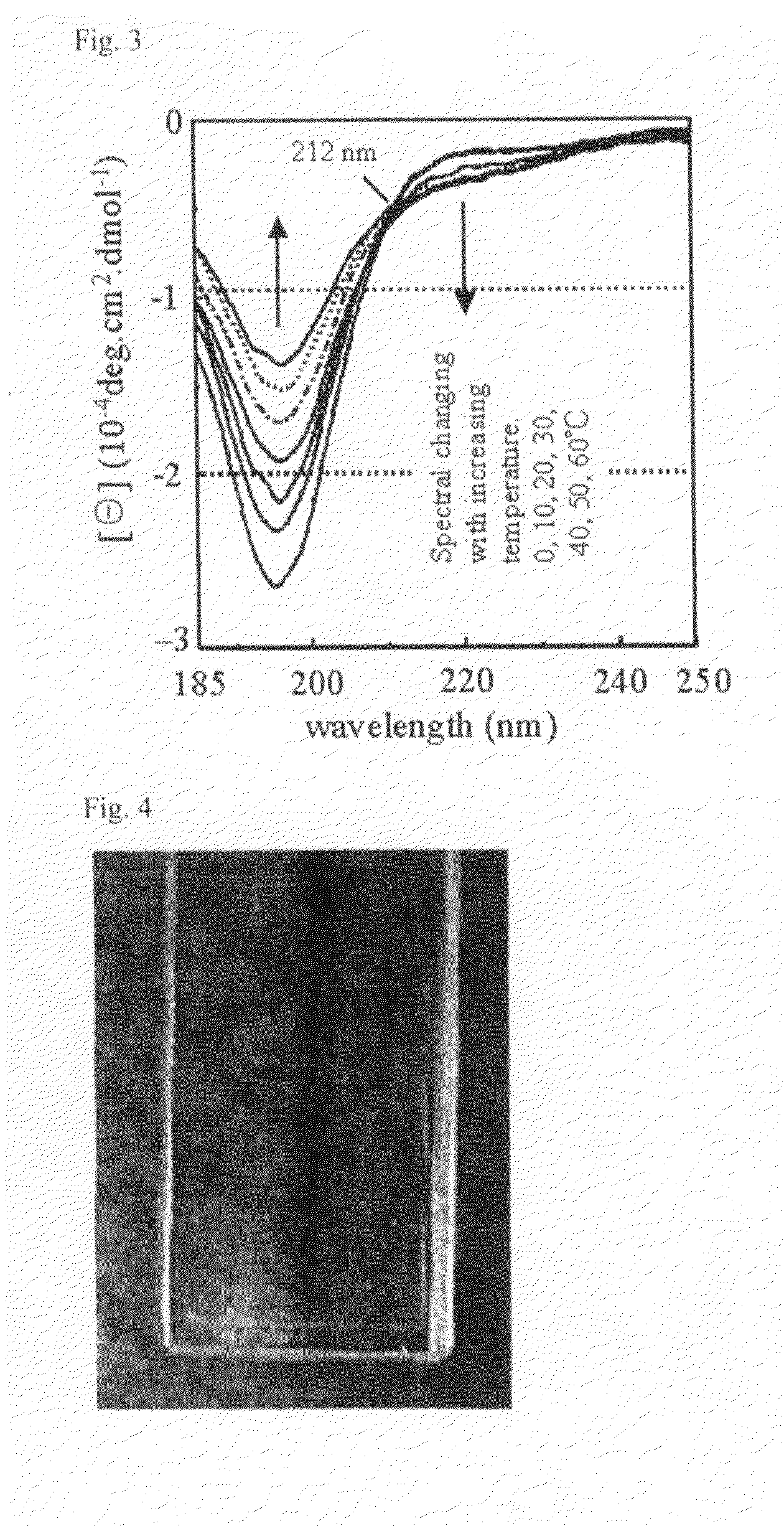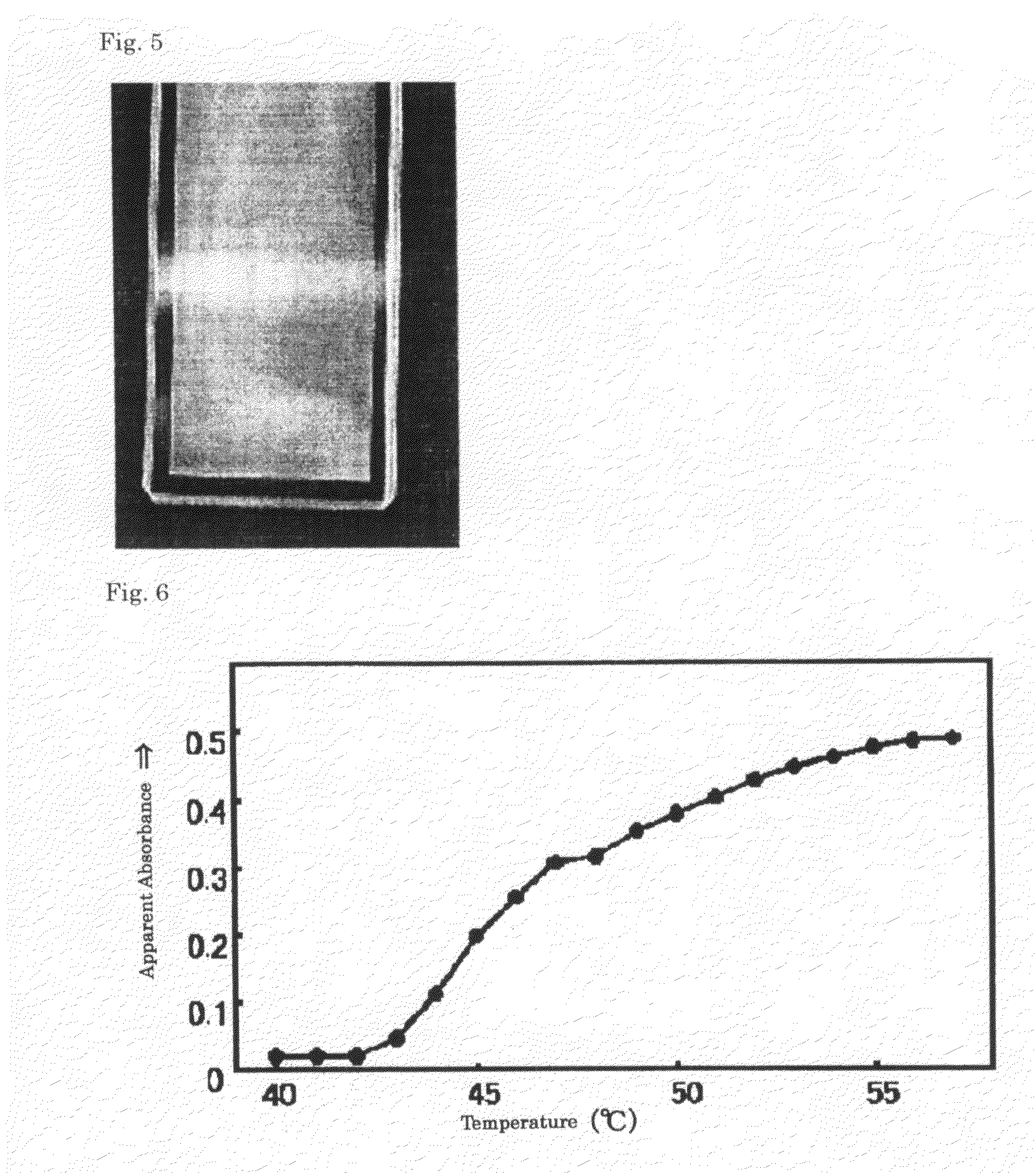Temperature responsive depsipeptide polymer
a polymer and temperature-responsive technology, applied in the direction of peptides/protein ingredients, peptides, immunoglobulins, etc., can solve the problems of slow biodecomposition speed, strong interactions between molecules and polyamino acids and oligoamino acids, and inability to bind to molecules by melting methods or solution methods,
- Summary
- Abstract
- Description
- Claims
- Application Information
AI Technical Summary
Benefits of technology
Problems solved by technology
Method used
Image
Examples
example 1
[0124](1) Synthesis of Boc-Gly-Val-Gly-Hmb-Ala-Pro-OBzl
[0125](1a: Synthesis of Valic Acid)
[0126]Valine (835 g, 0.5 mol) was put in a 1-L three-necked round bottom flask, and 500 ml of distilled water containing 1 M H2SO4 (18 M H2SO4, 27.7 ml) was added to dissolve valine. Next, the mixture was added with 2 equivalents of a saturate aqueous sodium nitrite solution (69.17 g) over 2 hours while being cooled with ice and stirred at 0° C. or lower. After stirring until no foam was generated, it was subjected to extraction with Et2O (about 1 L), and dried with NaHCO3 and concentrated to obtain a white crystal. Yield, 45.7 g (77.5%). 1H NMR (CDCl3, 300 MHz): 4.15 (1H, Hmb αCH); 2.09 (1H, Hmb βCH); 1.50, 1.00 (6H, Hmb γCH3).
[0127](1b: Synthesis of Boc-Gly-OSu)
[0128]Boc-Gly-OH (1.54 g, 8.82 mmol) was put in a 500-ml round-bottom flask, dissolved in distilled CHCl3, and added with DCU (2.18 g, 10.58 mmol) and HOSu (1.21 g, 10.58 mmol), followed by stirring under cooling. After the mixture was...
example 2
[0141](2) Synthesis of Boc-(Gly1-Val2-Gly3-Hmb4-Ala5-Pro6) -OBzl (n=2 to 6)
[0142](2a: Synthesis of Boc-Gly1-Val2-Gly3-Hmb4-Ala5-Pro6-OH) l
[0143]Boc-Gly1-Val2-Gly3-Hmb4-Ala5-Pro6-OBzl (1.14 g, 1.65 mmol) was put in a 500-ml round-bottom flask and dissolved in MeOH, and added with palladium carbon powder. After an apparatus was built, the round-bottom flask was filled with H2, and the mixture was stirred to initiate catalytic reduction reaction. Progression of the reaction was confirmed by elevation of a liquid surface, and the termination of the reaction was determined when spots of the raw materials in TLC were eliminated. After that, the palladium carbon powder was removed, and the filtrate was concentrated, followed by azeotropy with benzene. The residue was added with distilled CH3Cl-petroleum ether for crystallization. Yield, 9.28 g (93%); [α]D20=−87.4 deg. (MeOH, c 0.1), melting point=117-119° C. 1H NMR (DMSO-d6, 300 MHz): 12.39 (1H, OH); 8.51 (1H, Gly3·H); 8.14 (1H, Ala5·H); 7...
example 3
[0154](3) Synthesis of Poly(Gly-Val-Gly-Hmb-Ala-Pro)
[0155](3a: Synthesis of Boc-Gly1-Val2-Gly3-Hmb4-Ala5-Pro6-OSu)
[0156]Boc-Gly1-Val2-Gly3-Hmb4-Ala5-Pro6-OH (0.38 g, 0.63 mmol) was dissolved in distilled DMF and added with DCC (0.14 g, 0.69 mmol) and HOSu (0.08 g, 0.69 mmol), and the reaction mixture was stirred under cooling with ice overnight. After that, termination of the reaction was confirmed by TLC, and DCUrea was removed, followed by concentration, thereby a white powder was obtained. Yield, 0.35 g (80%). 1H NMR (DMSO-d6, 300 MHz): 8.50 (1H, Gly3 NH); 8.23 (1H, Ala5 NH); 7.63 (1H, Val2-NH); 6.99 (1H, Boc-Gly1 NH); 4.78 (1H, Hmb4 αCH); 4.71 (1H, Pro6 αCH); 4.52 (1H, Ala5 αCH); 4.23 (1H, Val2 αCH); 3.92, 3.60 (4H, Gly1 αCH2, Gly3 αCH2); 2.79 (4H, -OSu); 2.00 (4H, Pro6 βCH2, Val2 βCH, Hmb4 βCH); 1.21 (3H, Ala5 βCH3); 1.37 (9H, Boc t-Bu); 0.88 (12H, Val2 γCH3, Hmb4 γCH3); 2.00 (2H, Pro6 γCH2), 3.57 (2H, Pro6 δCH2).
[0157](3b: Synthesis of TFA·H-Gly1-Val2-Gly3-Hmb4-Ala5-Pro6-OSu)
[...
PUM
| Property | Measurement | Unit |
|---|---|---|
| temperature responsive | aaaaa | aaaaa |
| temperature | aaaaa | aaaaa |
| strength | aaaaa | aaaaa |
Abstract
Description
Claims
Application Information
 Login to View More
Login to View More - R&D
- Intellectual Property
- Life Sciences
- Materials
- Tech Scout
- Unparalleled Data Quality
- Higher Quality Content
- 60% Fewer Hallucinations
Browse by: Latest US Patents, China's latest patents, Technical Efficacy Thesaurus, Application Domain, Technology Topic, Popular Technical Reports.
© 2025 PatSnap. All rights reserved.Legal|Privacy policy|Modern Slavery Act Transparency Statement|Sitemap|About US| Contact US: help@patsnap.com



